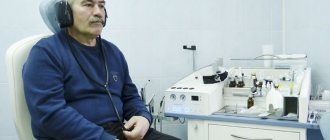To the reference book Sensorineural hearing loss is a lesion of one or more parts of the auditory analyzer.
Symptoms: hearing loss, tinnitus, dizziness and imbalance. Author:
- Sokolova Alla Vasilievna
otorhinolaryngologist, otosurgeon, doctor of the highest category
4.17 (Votes: 6)
Sensorineural hearing loss is a hearing loss that affects any of the sound-perceiving structures of the auditory analyzer. The conversion of sound wave energy in the organ of Corti of the cochlea (in some sources defined as sensorineural hearing loss) or the conduction of nerve impulses to the cerebral cortex may be impaired. Timely correction of pathological changes allows you to slow down or prevent the progression of the disease and avoid the development of complete deafness.
What is sensorineural hearing loss?
The perception of sounds is ensured by the coordinated work of all parts of the hearing organ. The outer ear (concha and ear canal) conduct sound waves to the middle ear. The eardrum converts the wave into mechanical vibrations. The auditory ossicles transmit these vibrations to the inner ear. The movement of fluid in the cochlea irritates the hair cells, which convert mechanical impulses into nerve impulses. The auditory pathways transmit signals to the temporal lobes of the brain, where the central part of the auditory analyzer is located. After processing impulses by cerebral structures, a person understands what he heard.
Types of sensorineural hearing loss
The International Classification of Diseases (ICD-10) identifies the following forms of sensorineural hearing loss:
- H90.3 - double-sided;
- H90.4 - unilateral with preserved function of the second ear;
- H90.5 - unspecified.
And also H91:
- H91.0 - ototoxic hearing loss;
- H91.1—presbycusis;
- H93.3—damage to the auditory nerve.
In clinical practice, congenital, or early, form of sensorineural hearing loss is distinguished and acquired (all other cases). Based on the duration of the disease, hearing loss can be:
- sudden (hearing decreases within 12 hours);
- acute (hearing loss occurs within 1–3 days, the disorder persists for about a month);
- subacute (hearing loss occurs over 1–3 months);
- chronic (the process drags on for 3 months or more).
Taking into account the nature of its course, hearing loss can be reversible, stable and progressive.
2. Sudden hearing loss
Acute sensorineural hearing loss can have such a rapid course that it is classified as a separate group, the so-called “sudden hearing loss.”
. In this case, significant or even complete deafness develops within several hours (up to half a day). This situation has a number of specific features. Sudden hearing loss often ends with an equally rapid recovery. If sudden sensorineural hearing loss occurs during sleep, the patient is awakened by a sensation that is described as a broken telephone wire, that is, sudden silence wakes the patient in the same way as a loud sound. Most often, sudden hearing loss is unilateral.
Visit our Therapy page
Degrees of sensorineural hearing loss
Based on hearing thresholds, there are 4 degrees of sensorineural hearing loss:
- First. The problem of sound perception is noticeable only in certain situations (noisy room, conversation with several interlocutors at once, etc.) The threshold is increased to 25–40 dB.
- Second. The perception of quiet speech and whispers is seriously difficult. The threshold is increased to 41–55 dB.
- Third. Problems arise with speaking. The hearing threshold is 56–70 dB.
- Fourth. The patient hears only loud sounds from sources located in the immediate vicinity. The threshold is increased to 71–90 dB.
Deafness is diagnosed if a person cannot hear even very loud sounds, more than 91 dB.
Causes of sensorineural hearing loss
Sensorineural hearing loss in children can be caused by:
- abnormalities of brain development;
- developmental disorders of the cochlea;
- adverse effects on the mother’s body during pregnancy (intoxication, previous infections, etc.);
- genetic mutations;
- difficult childbirth.
Acquired hearing loss may be associated with the following factors:
- head injuries;
- acoustic injuries (the most common is listening to music on headphones at high volume);
- barotrauma;
- past intoxications;
- viral diseases;
- acute and chronic otitis;
- treatment with ototoxic drugs;
- local and systemic metabolic disorders;
- tumors;
- vascular pathologies;
- work in hazardous conditions;
- autoimmune diseases.
The causes of acute sensorineural hearing loss are often traumatic factors (traumatic brain injury, exposure to toxins, infection, etc.). If treatment begins on time, in the first 3 days, there is a chance of complete restoration of hearing.
Chronic sensorineural hearing loss is most often associated with progressive changes in the structures of the inner ear. Treatment requires the elimination of provoking factors, the use of conservative methods to slow the development of pathology and rehabilitation measures (hearing correction).
Consequences
Adverse consequences are possible if you refuse to see a doctor and carry out a comprehensive diagnosis. First of all, ignoring the condition threatens complete one-sided deafness. Also, if the cause of hearing loss is a serious illness, refusal to undergo an examination will only lead to its gradual development and deterioration in overall health.
Lack of hearing causes both psychological and physical discomfort. Even if the problem is one-sided, difficulties arise with communications, timely response to dangerous situations, and so on. Therefore, if signs of acute deafness appear, do not try to treat it yourself, but consult a doctor.
How does the disease manifest itself?
Hearing problems can manifest themselves clearly or develop unnoticed by the patient. Acute sensorineural hearing loss is characterized by a sudden loss or progressive decrease in hearing in one or both ears, as well as one or a combination of the following symptoms:
- tinnitus of various types (high-frequency ringing or squeaking, low-frequency noise, etc.);
- vestibular dysfunctions (dizziness, nausea, vomiting, coordination problems, etc.);
- autonomic dysfunctions (sweating, rapid heartbeat, changes in blood pressure, etc.).
At the beginning of the development of chronic pathology, the clinical picture may be erased. The patient should be alert to the following situations:
- during a regular or telephone conversation you constantly have to ask again;
- there are difficulties communicating in an environment with background noise (on the street, in public places, etc.);
- understanding the interlocutor requires observing his lips;
- There are regular problems with identifying the source of noise.
The attention of loved ones should be attracted by oddities in a conversation (for example, a person hears words incorrectly or does not catch the meaning of what was said), watching TV at excessive volume, lack of reaction to events accompanied by noise (outside the patient’s field of view), and others.
Symptoms
When hearing loss is suspected to be due to a condition such as sensorineural hearing loss, symptoms will help determine the correct diagnosis. In this case, typical symptoms are:
- Sudden loss of hearing on one or both sides. The person indicates that he has become worse at understanding speech and perceiving high-frequency sounds;
- The appearance of tinnitus. This is not a permanent symptom. But it may indicate the cause of decreased hearing - acute injury, acute disruption of blood flow in the artery of the labyrinth, intoxication.
Qualified doctors who work in the Nearmedic clinic network necessarily assess the presence of risk factors. To do this, they ask the patient targeted questions:
- Do you have any relatives in your family who suffer from hearing loss?
- Is the work associated with high noise production conditions?
- Have you had any dangerous infections in the near future (measles, mumps, flu, meningitis, etc.)?
- Have you taken drugs from the ototoxic group (see above)?
Only after this comes the stage of objective examination. The otolaryngologist has an otoscope at his disposal during the appointment. This is a device that allows you to precisely examine the outer parts of the ear and the eardrum. It is not possible to look into the internal sections, but based on the condition of the peripheral sections, it is possible to identify some causes of decreased hearing - inflammation, degenerative processes, etc.
At the same time, the doctor evaluates the symmetry of the face. This sign allows us to exclude the involvement of cranial nerves in the pathological process, which is especially often observed with herpes infection.
Where to go if you have symptoms of hearing loss?
The diagnosis of sensorineural hearing loss is carried out by an otolaryngologist or audiologist. The first stage includes a survey, medical history and examination of the ears using a special device.
Laboratory examination involves a general blood test; according to indications, a coagulogram, blood biochemistry, and hormone tests are prescribed. Instrumental diagnostics includes the following options for a comprehensive hearing test:
- tests with whispered and spoken speech;
- tuning fork tests;
- pure tone threshold audiometry;
- impedancemetry;
- recording of auditory evoked potentials;
- otoacoustic emissions;
- extratympanic electrocochleography.
To assess hemodynamics in the structures of the auditory analyzer, duplex scanning of the brachiocephalic vessels is prescribed. To exclude serious causes of hearing loss (complications of injury, vascular pathology, tumor, etc.), CT and/or MRI of the head and neck are performed.
How is sensorineural hearing loss treated?
In accordance with clinical recommendations, acute sensorineural hearing loss is treated under the close supervision of an audiologist, who dynamically evaluates the effectiveness of therapy and, if necessary, carries out its correction. Treatment options include:
- hearing-friendly mode;
- hormone therapy;
- complex therapy with drugs to improve microcirculation and rheological properties of blood, antioxidants and antihypoxants.
In chronic sensorineural hearing loss, concomitant diseases are treated first. Twice a year, the patient must undergo courses of drug treatment using drugs to improve intracerebral and labyrinthine circulation and correct metabolism. At the same time, hearing aids are provided using a hearing aid.
The unsatisfactory effectiveness of hearing aids in severe sensorineural hearing loss is the reason for cochlear implantation.
Audiologists at the Ear, Nose and Throat Clinic successfully diagnose and treat sensorineural (sensorineural) forms of hearing loss. The clinic has equipment to conduct a complete diagnosis of hearing pathologies. The treatment program is drawn up taking into account the cause and characteristics of the development of disorders. Hearing aid is provided according to indications. Doctors at our medical center provide care to both adults and young patients.
Modern treatment at Nearmedic
Treatment of sensorineural hearing loss using modern methods is carried out at the Nearmedic center. To do this, doctors use the latest scientific developments in this matter. Specialists have drugs from different groups in their arsenal. Surgical treatment for this pathology is not indicated.
Depending on the characteristics of the course of the disease and identified risk factors, otolaryngologists from the Nearmedic network of clinics develop an individual treatment program for each patient. If acute sensorineural hearing loss is diagnosed, treatment is carried out only in a hospital setting, while maintaining a gentle auditory regimen is mandatory (exposure to loud sounds is excluded).
In the acute period, otolaryngologists must prescribe:
- Infusion therapy to restore normal microcirculation in the inner ear and reduce the degree of intoxication;
- Corticosteroid drugs that reduce the severity of edema and the inflammatory reaction (it is these conditions that are destructive to nerve cells, so they must be eliminated very quickly). In some cases, otolaryngologists may inject corticosteroids through the eardrum and into the auditory tube to increase the effectiveness of treatment;
- Antiplatelet agents to reduce blood viscosity and improve its flow through blood vessels, incl. in the area of the inner ear.
If this is chronic hearing loss, then the treatment measures are of a slightly different nature. These are supporting courses 1-2 times a year, which are aimed at:
- Improving blood flow in brain tissue, incl. in the labyrinth area;
- Normalization of metabolism in nerve cells and tissues.











